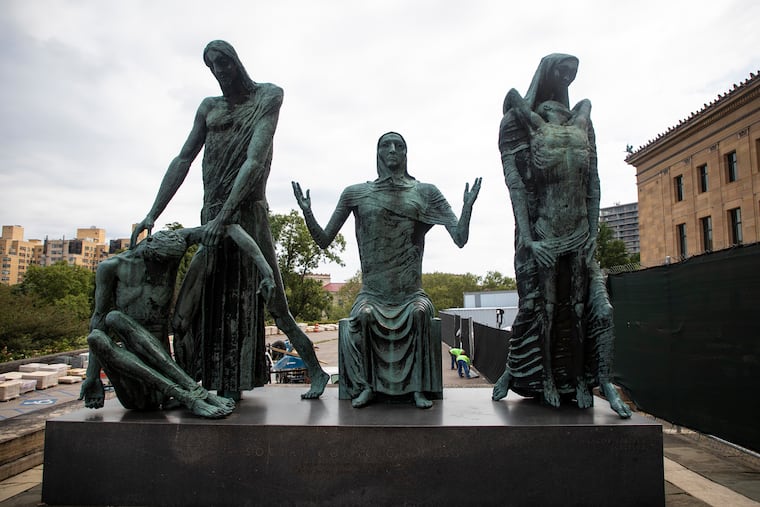Art Museum sculptures that have stood sentry for decades are moving to Penn for 99 years
Enormous sculptures by Louise Nevelson and Jacob Epstein will move to the University of Pennsylvania campus after decades at the western entrance of the Philadelphia Museum of Art.

Two enormous pieces of public art, standing for decades outside the west entrance of the Philadelphia Museum of Art overlooking the Fairmount Water Works, will be relocated beginning July 15 to new sites on the campus of the University of Pennsylvania.
The move of the well-known works — Louise Nevelson’s Atmosphere and Environment XII and Jacob Epstein’s Social Consciousness — is prompted by the museum’s ongoing construction work, which now effectively traverses the north side of the building and will soon consume the west terrace.
Both works are owned by the Association for Public Art, a nonprofit organization devoted to public art in Philadelphia, and have been “temporarily” sited at the Art Museum — in the case of the Epstein since 1955 and for the Nevelson since 1973. The pieces will now be on loan to Penn for 99 years.
Penny Balkin Bach, executive director and chief curator of the association, said the organization began discussing relocations with the Art Museum two years ago.
Timothy Rub, director and chief executive of the Art Museum, said that the museum’s massive “core project" construction that will transform the interior of the building has reached the point where the west entrance must be closed. It will reopen in about a year.
There will be “major renovation” of Lenfest Hall, the entrance hall inside the building, Rub said. Construction of what the museum calls “the forum” — an enormous multilevel space made possible by demolition of the old auditorium — is beginning as well.
The west terrace, he added, will be completely rebuilt.
In September, the museum’s old north entrance, on the side facing the Perelman Building on Kelly Drive, will open for the first time since the 1960s. All this work will take about a year. The sculptures had to move.
“We wanted to keep these important artworks in continued public view and avoid placing them in storage, which sometimes is inevitable in situations like this one,” said Bach. “It’s not uncommon, especially with large-scale works, they go into storage. ... We work very hard not to have that happen.”
Lynn Marsden-Atlass, Penn curator and head of the Arthur Ross Gallery, said the university was first approached by the association in the fall of 2017 as a possible home for the sculptures. The idea was “enthusiastically” endorsed and recommended by a campus art review committee, she said.
Sites were selected and approved, and university president Amy Gutmann gave the final go-ahead.
Social Consciousness will be located near the Van Pelt Library along Memorial Walkway. The Nevelson will be sited on South 33rd Street in a green space near the Palestra.
Epstein’s Social Consciousness, which consists of five bronze figures up to 12 feet tall, was commissioned by the association, then known as the Fairmount Park Art Association, in 1950 for the Ellen Phillips Samuel Memorial next to the Schuylkill along what is now Kelly Drive.
As the sculpture took shape — it is intended to express the American ideal of brotherhood — it became clear that it would be too large to fit with the Samuel memorial, and Epstein was not altogether happy with the location “near a roadway,” Bach said. Social Consciousness depicts a sorrowful “Eternal Mother” flanked by two figures who are holding stricken and dying figures.
The Art Museum was deemed an alternative, temporary location and Social Consciousness was installed at the museum’s west entrance in 1955. Its location placed it opposite another poignant sculptural array — Auguste Rodin’s Burghers of Calais, which had just been relocated from outside the Rodin Museum down the Benjamin Franklin Parkway a month or two earlier.
While the Burghers departed from its spot for a lengthy sojourn in Montreal for the 1967 Expo, the two sculptures defined the museum’s west entrance until the early 1970s. At that point, Burghers was moved inside the Rodin Museum, at least in part to slow atmospheric damage to its bronze surface.
It also happened that another enormous sculpture needed a spot.
In 1971, the association acquired Nevelson’s Atmosphere and Environment XII. The piece had been in front of the Seagram’s building in New York City, but in March of 1973, it was installed at the Art Museum — atop the pedestal that once supported Burghers of Calais. (In fact, beneath facing stone, the pedestal still bears the carved title Burghers of Calais.)
Atmosphere and Environment XII is an abstract composition that was likened to stacked “orange crates” in an Inquirer story from 1973. But it is anything but rickety. The piece is constructed from 18,000 pounds of Cor-Ten steel columns bolted together forming an 18-foot-high see-through wall.
“Nevelson worked at such a scale with industrial materials,” Bach said, “and [in doing so] she opened the door for so many women sculptors.” Atmosphere and Environment XII is a classic example of Nevelson’s “muscle," she said, helping to transform the very concept of sculpture and who practices it.
“It’s a huge opportunity for us to continue to share these works,” said Marsden-Atlass, the university curator, who oversees a collection of about 8,000 works of art in 100 locations around campus.
She said that the Epstein would undergo extensive conservation work directed by the association once the piece is installed. The Nevelson was conserved in 2007. Whether it needs additional work will be determined once the sculpture is unbolted and separated into its parts.
“My dream is that it comes directly and is installed immediately,” said Marsden-Atlass.